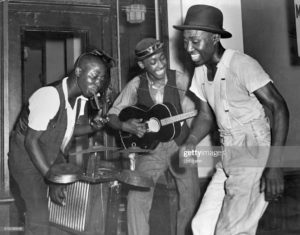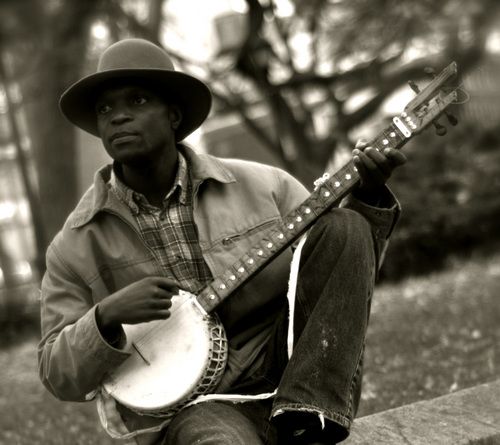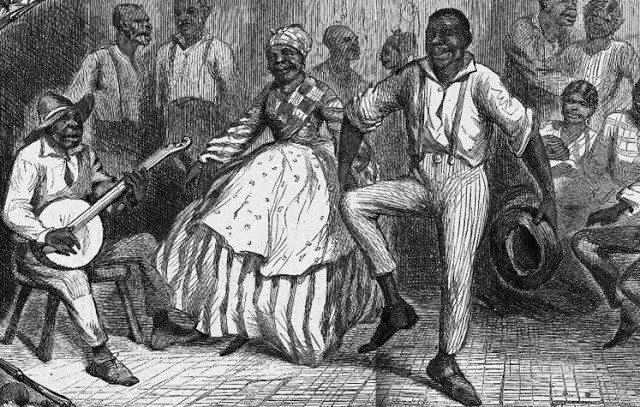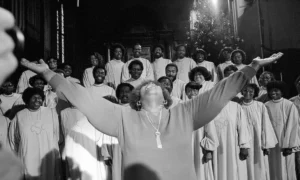Folk Music Was Life Support For Slaves



What does Folk Music consist of?
Folk music utilizes the drums, xylophone (also known as the balafo or balaphon), quills (a form of panpipes), horns and banjo. According to J. H. Kwabena Nketia folk music includes multipart rhythmic structures, repetitive choruses, a lead singer and a call-response. Folk music differs from European music which consisted of sedate dances and regular rhythmic patterns. Europeans did not like African music because it was too complex and too “noisy” due to the polyrhythm it consisted of.
The banjo is a key instrument to folk music. The banjo originated in Africa. Richard Jobson, a British trader who visited Africa in 1620-21 described what was most likely one of the first Banjos. Jobson described an instrument with a neck fastened to it with up to 6 strings made from gourd. The banjo was found throughout the Caribbean and North American mainland. There are several names for the banjo including banza, banjah, bandore and banjar.
The History of Folk Music

Prior to slavery, music in Africa was not used as a performance it was used in everyday life. There was no audience cheering them on. Music was used to regulate the pace of work, it was used at festivities and many sang to themselves about the work they were doing. Music was also used for derisive singing even in reference to the King. Such behavior would not have been accepted in the form of speech without great consequences. This was adapted to the life in the New World. It was difficult to document African music because of how complex it’s polyrhythm. Before sound recording like we have today a notational system was used for European music.
Double Meanings
Many of the Folk songs contained secret messages. Most of the time these messages were directions for the slaves to follow to freedom. In other cases it might’ve been to say things about white people that they wouldn’t have been able to in speech. For example, if the overseer had been working them hard one day they might complain about it through folk music. Before they were outlawed drums played an important role in sending messages to other slaves. It took the white people a long time to realize the enslaved Africans were utilizing the drums as a form of communication. It was not until 1739 that drums were outlawed due to the insurrection in Stono, South Carolina. Harriet Tubman was known for singing the folk songs with secret messages to tell the other slaves how to follow the stars to freedom. The most known songs Tubman sung were “Wade in the water” and “Go Down Moses”.
Singing To Get Through The Pain
It’s well know that slavery was harsh and slaves suffered dearly. Many of us ask “how did they manage to get through it?” Folk songs were one of the things that helped them push through slavery. Not all folk songs were somber and depressing, some were uplifting and in high spirits.The slaves sang songs all the time, just as they did in Africa before being brought to America as state above. Slaves sung while they worked whether as a group or by themselves. Singing helped them maintain the speed of the work and helped push the slow workers to work faster. By keeping the slaves in high spirits it ultimately helped take some of the focus off the harsh environment and prevented depression.
Forced Singing and dancing
In some cases overseers would force slaves to sing or dance for their entertainment for no other reason then they could. This happened while they were working as well. On the journey from Africa to the “New World” the slave catchers would make the slaves come up to the deck to sing and dance for exercise. Going back to the secret messages, since the slave catchers didn’t understand what they were saying sometimes the slaves would try to put together plans on overtaking the ship. Amistad is a well known slave ship that was overpowered by the slaves. The Africans used secret messages in the songs the sung as part of their plan. In the situations where overseers or slave masters forced the enslaved to dance and sing the enslaved Africans had no choice or they’d be killed.
Folk Music’s Influence Today
Hambone
After drums were outlawed the slaves had to utilize hand clapping, foot stomping and patting juba. Patting juba is extended hand clapping, what we call hambone. The earliest it’s dated is the 1820s and it got real recognition in the 1830s. Another version of patting juba was using two sticks to beat on the floor. This version could be by itself or with other instruments.
Conclusion
Despite White European influence that surrounded African Americans their music still contained characteristics from African music. This still applies to the music today, it all stems from folk music. From folk music it allowed African Americans to gained the skill of improvising, they were able to make songs up at any time to fit any situation.
More By The Author

The History Of Jazz
In this course I learned the Roots of the music genre Jazz. This consisted of learning the different styles that emerged from Jazz such as:

Free Jazz – Albert Tyler’s “Spiritual Unity”
Spiritual Unity Breakdown Track 1 & 4- Ghosts Track 2 – The Wizard Track 3 – Spirits Track 5 – Vibrations Overall Listening to this

Max Roach – Bebop Musician
Maxwell or Max Roach was born on January 10, 1924 in NewLand North Carolina. Seeking better opportunities his parents moved Roach and his family to

Whack World: Genius of Tierra Whack- Imani Blue
/*! elementor – v3.18.0 – 08-12-2023 */ .elementor-heading-title{padding:0;margin:0;line-height:1}.elementor-widget-heading .elementor-heading-title[class*=elementor-size-]>a{color:inherit;font-size:inherit;line-height:inherit}.elementor-widget-heading .elementor-heading-title.elementor-size-small{font-size:15px}.elementor-widget-heading .elementor-heading-title.elementor-size-medium{font-size:19px}.elementor-widget-heading .elementor-heading-title.elementor-size-large{font-size:29px}.elementor-widget-heading .elementor-heading-title.elementor-size-xl{font-size:39px}.elementor-widget-heading .elementor-heading-title.elementor-size-xxl{font-size:59px} Who is Tierra Whack? Tierra Whack, a Grammy nominee, Double-XXL freshman,

Jazz as a Catalyst for Social Change: A Harmonious Connection – Imani Blue
/*! elementor – v3.18.0 – 08-12-2023 */ .elementor-heading-title{padding:0;margin:0;line-height:1}.elementor-widget-heading .elementor-heading-title[class*=elementor-size-]>a{color:inherit;font-size:inherit;line-height:inherit}.elementor-widget-heading .elementor-heading-title.elementor-size-small{font-size:15px}.elementor-widget-heading .elementor-heading-title.elementor-size-medium{font-size:19px}.elementor-widget-heading .elementor-heading-title.elementor-size-large{font-size:29px}.elementor-widget-heading .elementor-heading-title.elementor-size-xl{font-size:39px}.elementor-widget-heading .elementor-heading-title.elementor-size-xxl{font-size:59px} Origins of Jazz Picture this: The dawn of the 20th century,

Evolution of Black Gospel Music: A Comparative Analysis with Contemporary Gospel -Imani Blue
Black gospel music is deeply intertwined with the African-American experience, having evolved into a compelling and influential genre within the broader spectrum of gospel music.

